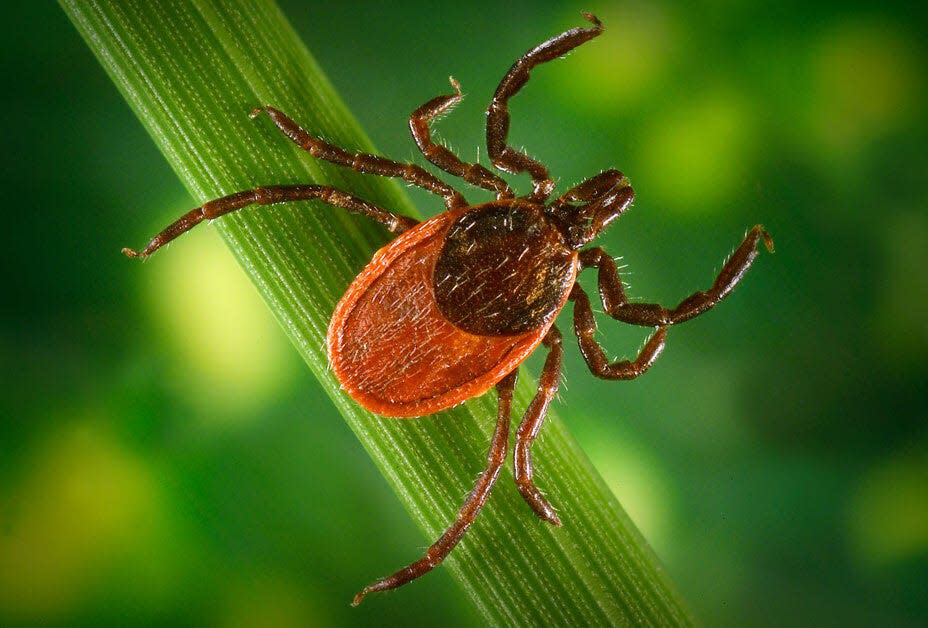Lyme disease cases soar across the Southern Tier. Here's what you need to know
Beth Scoville almost didn't see the tick, and doctors almost didn't find the potentially devastating ailment — Lyme disease — the tiny parasite left behind.
As a result, Scoville, who lives in Endicott, endured months of pain, mental confusion and treatments.
Now, public health officials across the Southern Tier fear thousands of others could face the same fate, as confirmed cases of Lyme and other tick-borne diseases are surging.
Scoville doesn't want others to suffer as she did.
"I am 90% normal," said Scoville, 52, who contracted Lyme six years ago. "I hike, I run. I know I get 'Lyme ache' in my knees and joints. Knock on wood that's it. It's taken a long time."

What is Lyme disease?
Lyme disease, caused by the bacterium Borrelia burgdorferi, is the most common vector-borne illness in the United States, according to the U.S. Centers for Disease Control and Prevention.
The disease is transmitted to humans through the bite of infected blacklegged ticks, also known as deer ticks.
Typical symptoms include fever, headache, fatigue, and a characteristic "bull's eye" skin rash. Left untreated, Lyme disease infection can spread to joints, the heart, and the brain and nervous system.
Health officials sound the alarm over spike in tick-borne diseases
Regional health care providers are seeing a worrisome increase in Lyme disease cases this year.
"All last year we had 2,742 cases of Lyme patients," said Dr. Victor Kolade of Guthrie, which has facilities in 12 counties in New York and Pennsylvania. "Currently year to date, we have 2,644 cases."
Related How bad is 2023 tick season in NY? What we know so far, and how to avoid Lyme disease
The jump in Lyme cases reflects a trend being reported by counties across the Southern Tier:
Broome County: 2022: 704 confirmed cases. 2023: 504 cases through July.
Chemung County: 2022: 132 cases. 2023 to date: 123 cases.
Schuyler County: 2022: 63 cases. 2023 to date: 50 cases.
Tioga County: 2022: 210 cases. 2023 to date: 173 cases.
While Steuben County doesn't keep its own Lyme disease statistics — the county relies on the New York State Department of Health to track those numbers — Lorelei Wagner, Steuben County public health education coordinator, said "anecdotally, we have heard about ticks being very prevalent in the area."
Erin Clary, state Health Department public information officer, also said surveys indicate the abundance of ticks infected with Lyme disease seems to be on the rise in the county.
Ticks spread more than just Lyme disease
While Lyme disease cases are spiking across the region, it isn't the only threat.
Many counties are seeing an increase in other tick-borne illnesses, including babesiosis, a parasitic disease that can destroy red blood cells, and anaplasmosis, which can cause fever, headache, chills, and muscle aches.
For example, Broome County reported 34 cases of anaplasmosis in 2022, and already had 38 confirmed cases by the end of July this year.
Transportation Why are gas prices in NY so high, and when could they come down? What to know
There are several possible reasons Southern Tier counties are seeing more cases, according to Elizabeth Smalt, public health educator with the Broome County Health Department.
"This could be associated with people traveling to other states or counties, and could also be because ticks are migrating to our area," Smalt said.
A difficult disease to diagnose
It was a day in 2017 when Scoville noticed a tiny speck on her hip, thinking it was a mole. A closer inspection revealed it was a nymph stage tick.

Months later, when Scoville started feeling seriously ill, she was initially diagnosed with multiple sclerosis, and might have accepted that conclusion, if a friend hadn't urged her to get a second opinion.
Education How should schools deal with gender issues, book banning? NYS officials lay it out
After consulting a specialist and taking more sophisticated tests, Scoville discovered the real culprit — Lyme disease.
"I spent eight months on antibiotics," she said. "Once it's chronic, it's a lot harder to get rid of Lyme."
A Lyme disease diagnosis is often missed for a variety of reasons, Kolade said.
People don't always realize they have been bitten by a tick, and the telltale bull's-eye rash doesn't always appear, he said. The symptoms of Lyme disease also often mimic those of other ailments.
Delays in treatment can often lead to serious consequences, Kolade said, including long lasting and even permanent damage to joints and internal organs, and neurological impairment.
Lyme disease prevention tips
If diagnosed early, Lyme disease is readily treated with antibiotics.
There is currently no vaccine to prevent infection, and experts say the best defense against Lyme is to avoid exposure in the first place.
"In tick-infested areas, your best protection is to avoid contact with soil, leaf litter and vegetation. However, if you garden, hike, camp, hunt, work or otherwise spend time in the outdoors, you can still protect yourself," said Samantha Hicks, public health program coordinator for the Chemung County Health Department.
Tips for limiting risk include wearing light-colored clothing to spot ticks easily, tucking pants into socks or boots and shirts into pants, wearing insect repellant, and doing a full-body tick checks at the end of the day, Hicks said. Children and pets should be checked as well, she added.
If you find an embedded tick, remove it as soon as possible with a pair of tweezers, grasping it right where it enters the skin, Hicks said. Then kill the tick by placing it in a container of rubbing alcohol, clean the wound with rubbing alcohol or hydrogen peroxide, and watch for a rash or flu-like symptoms.
The state Department of Health also offers a list of Lyme disease prevention tips on its website.
Most importantly, according to Scoville, be aware, but don't stop living your life.
"I was scared to go outside again, but you can't live like that," she said. "You just have to be cautious."
Follow Jeff Murray on Twitter @SGJeffMurray. To get unlimited access to the latest news, please subscribe or activate your digital account today.
This article originally appeared on Elmira Star-Gazette: Some Southern Tier counties report spike in Lyme disease cases

